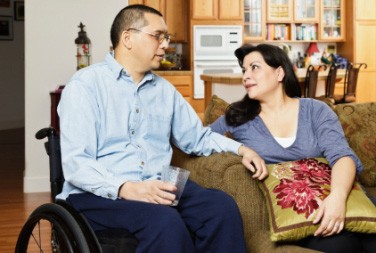Home Insurance Needs for People with Disabilities
Thanks to technology and medical advances, people with disabilities can have a home that’s customized to fit their needs. However, if you make any major modifications, make sure you have enough homeowner’s insurance to cover them.
Homeowners should understand the value of any additions they make on their house, whether it’s a wheelchair ramp or a deck, says J.P. Wieske, a spokesman for the Wisconsin Office of the Commissioner of Insurance. “If the dollar amount is significant, they should touch base with their insurance agent to see if they need to make any adjustments to their policy,” Wieske says.
While some renovations may be covered under your basic policy, don’t leave it to chance, says Paul Tobin, president of the National Spinal Cord Injury Association. People with disabilities often make major modifications to their homes, such as the addition of a wheelchair lift, the installation of an environmental control unit (a device that allows people with mobility impairments to operate electronic devices) or an upgrade of the electrical system. Not only should you tell your insurance agent or company about such improvements, but you should make sure they’re mentioned in your policy, Tobin says.
Protect your possessions
Modifications aren’t the only factors that could influence your home insurance policy. If you have expensive medical equipment, ask your agent or broker whether it’s wise to buy a separate rider – a policy add-on – to cover it.
“A power wheelchair can cost $10,000 to $12,000,” Tobin says.

Not only would a separate rider ensure that you can replace the wheelchair if it’s destroyed or stolen, but you may not have to worry about paying a deductible for the wheelchair if you file a claim.
It’s also important to keep a list of what you have in your home, as well as the value of the items and their estimated replacement costs. Keep receipts for your medical equipment stored in a safe place such as a safe deposit box so you can easily provide them to your insurance company. Finally, take pictures of your medical equipment.
Don’t forget caretakers
Some people with disabilities have caretakers who visit regularly. If that’s the case, liability is a concern because there’s always the possibility that the caretaker can fall and get hurt in your home or on your property. If that happens, you can be hit with an expensive lawsuit “and wind up losing the home,” Tobin says.
If the caretaker is a professional, such as a nurse or a home care aide, fewer liability issues will crop up since that person already should be licensed and insured, says Tully Lehman, a spokesman for the nonprofit Insurance Information Network of California. However, you should talk with the health care professional’s employer to make sure.
“You want to ask them, ‘What happens if someone gets hurt? Does your insurance cover that or does mine?’” Tobin says. If they’re not insured or aren’t willing to answer your questions, search for a different health care agency, he says.
If you have a private caretaker or you regularly have friends or neighbors checking in on you, you want to limit your exposure to lawsuits as much as possible. One way to do that is to try to reduce safety hazards, Lehman says. For example, if you own a lot of medical equipment, store it in areas where there isn’t much foot traffic. Likewise, make sure you have good lighting so people are less likely to trip.
It’s also a good idea to consider an umbrella liability policy. Home insurance policies typically provide about $300,000 in liability coverage, Lehman says. However, with an umbrella policy, you can get $1 million or more worth of coverage.
When it comes time to find new insurance coverage, we can help!
